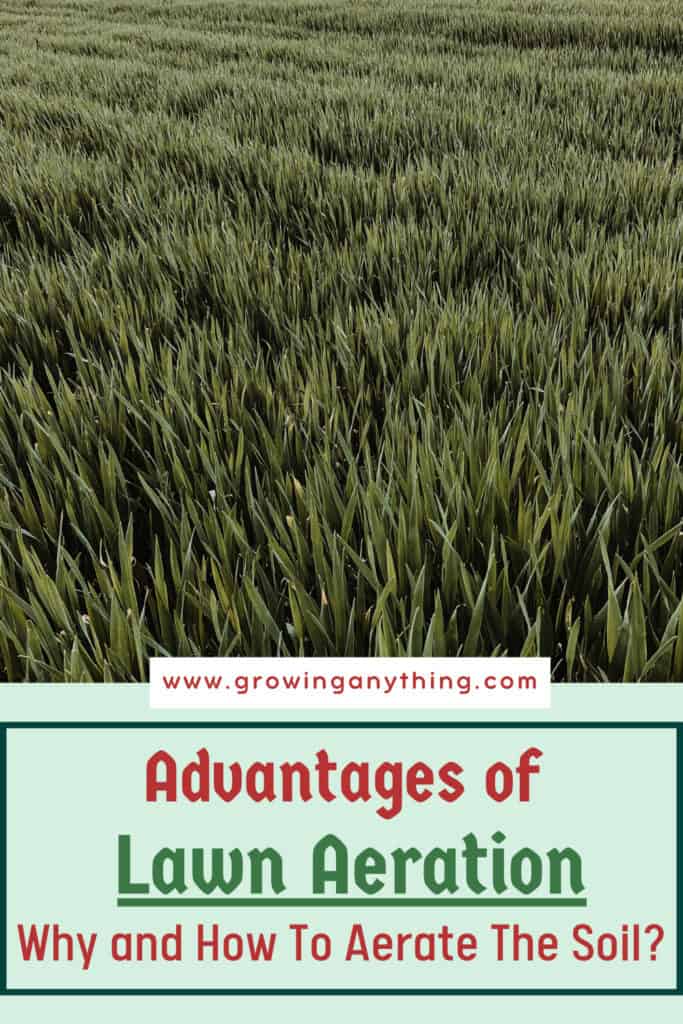Top 5 Advantages of Lawn Aeration
When you want to enjoy the “fruits of the Earth” and maintain a nutritious, healthy lawn, there are simple yet basic practices to take care of the soil. Most people already know about watering, fertilizing, or mowing.
But few consider ensuring that all the nutrients necessary for plants can reach the soil, even beneath the grass layers.
Aeration is a vital process that helps in maintaining a healthy lawn. During aeration, you allow the air and water to penetrate the greenery layers or the lean thatch.
The seeds you are planting, whether they are grass, plants, fruits, or vegetables, need space below the ground to absorb nutrients and water.
It is what people call “soil’s breath.”
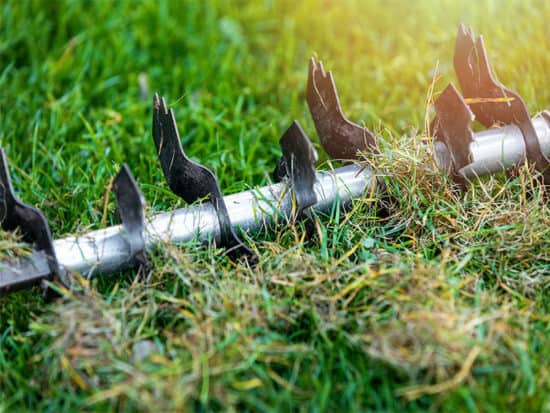
Ultimately, once aerating the lawn, the soil will get lots of benefits. The same applies to you, the gardener. One the lawn is healthy, it can drop the temperature of your home’s environment and surroundings. This translates into energy saving costs.
Furthermore, aerating the soil will help you protect the lawn against many problems due to soil compaction: dryness, drainage issues, fungal disease, and many more.
Learn how to get rid of thatch, as well as the benefits of aerating a beautiful lawn.
What Is Aeration?
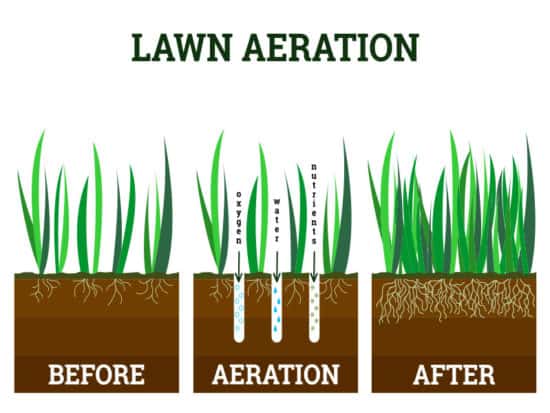
Before learning why and how to aerate the lawn, it is essential to know what this process means.
Aeration or perforation involves allowing water, air, as well as other nutrients to penetrate the grassroots. So, aeration involves perforating the soil by making small holes into it. This way, all the nutrients will reach the plants’ roots, grow deeply, and, therefore, produce a more robust, healthier lawn.
Why Should You Aerate the Lawn?
Why is the process of aerating the lawn so important? Can you skip it? Is it wise to apply it every year? So many questions, right? Especially when you do not have too much experience preparing the soil for plantation.
Let’s answer the first question above: which is the main reason gardeners aerate the lawn?
Because usually, the soil is very compact. Due to this compact texture, air, water, and other essential nutrients do not circulate properly into the earth.
For instance, a compacted layer of just ¼ to ½ inches can make a huge difference when it comes to the health and nutrition of the soil. The process of aerating the soil creates little holes in the lawn, so it will alleviate compact soil.
Once the plants’ roots are deprived of their critical needs, such as water, heat, or other stressful situations, the greeneries will lose their rich color and health. As a result, grass will grow thinner and thinner and eventually die completely.
So even one aeration session can bring an essential apport for the roots’ health. Learn more about this process by scrolling down.
When Do You Need To Aerate Lawn?
Well, even if it does not seem your lawn is too compacted, this natural process happens more often than you think. Some of the reasons why the lawn gets too compact are:
Vehicles or small grass cutting vehicles, which once driven on the lawn, become some of the main offenders
Outdoor entertaining and fun kids equipment that can leave marks on the grass
Clay soil that usually needs annual aeration to keep it thin and weak
If you notice the soil and grass look too compact, stressed and that the ground is too hard to touch, then you may have compaction issues.
Furthermore, if the earth does not absorb water as it should, then this is the main sign that you should aerate the soil. You can confirm the suspicions by using a screwdriver tool.
All you need to do is to take a regular screwdriver and stick it into the soil by hand. When the soil is too compact, the tool won’t slide too much. On the other hand, if you meet resistance, it means the soil is too tight, and aeration is mandatory.
How Should You Aerate The Lawn?
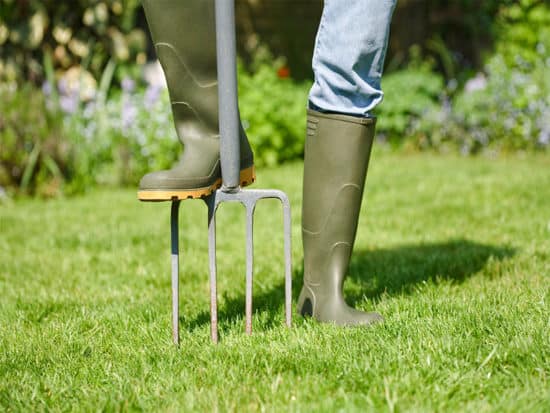
There are multiple ways to aerate the lawn. If you need to deal with smaller lawn areas, you can do this job manually. You can use some aerating sandals, special shoes with spikes that can aerate the lawn by simply walking.
In the same way, you can simply use a fork into the lawn, and start wiggling it back and forth, so you can fracture all the soil surface. The space and holes between these should be around 8 and 10 cm.
As such, you may need to go over the area for good results once again, following a different direction each time you go.
The Steps To Aerating The Yard
If you have never aerated the lawn before, the steps are not complicated, but they need to be closely followed:
Step 1: First of all, carefully mark underground sprinkler lines and heads’ location. Then use the cables and lines to delimit all the septic systems to avoid damaging them while aerating.
Step 2: You should thoroughly water the area two days before the aeration process. This should be somewhere two or three centimeters deep. The water will penetrate the lawn faster and make the plugs fall out more quickly.
As such, before you start aerating the lawn, you should make sure the soil is adequately moistened.
It is so frustrating to aerate soil that is too compact and bone dry. I recommend you to aerate the lawn one day after a rain shower or watering the soil. It will make your work way easier.
Step 3: The best moves while aerating the lawn are the natural ones. It should be like trying to move the lawn lengthwise, then widthwise. Most of the aeration machines people are using will cover only a small part of each pass’s soil surface.
Considering this, you should make multiple passes to cover all the most compacted areas.
Although it seems a lot of work, in time, it will help you save lots of resources and energy, without affecting any areas.
Step 4: After you have passed all through the lawn area, it’s time for the final touch. When you have finished your work, you can improve the soil’s quality only by top-dressing the soil with a few millimeters of compost.
You can also use some composted manure. Take all that compost and spread it over the surface of the lawn, so you can fill in the aeration holes.
Furthermore, you should reseed or fertilize the soil right after the aeration process for the best results. This activity is essential with or without the top-dressing mentioned above.
Aerating The Lawn – Tools to Use
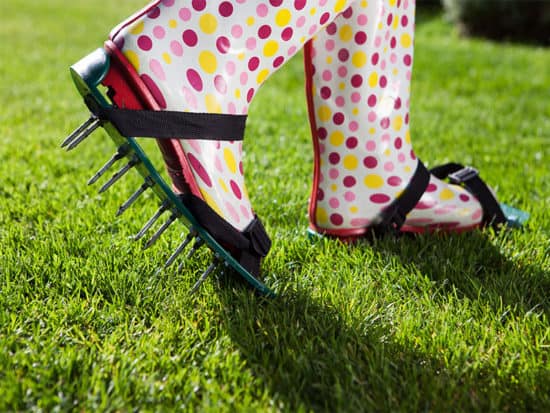
Whether you choose to aerate the lawn manually or using motorized equipment, you have three main types of tools to use, from small manual versions to other larger, heavier tractor-like ones. Let’s see together the main categories of this aerating machineries:
Spike Aerators: these are the most straightforward tools to use for aerating the lawn, as they will simply poke some holes down into the soil. Usually, these spike aerators come with solid, spike-like tines.
Some gardeners even use the special aerating “sandals,” some comfortable to wear shoes that will aerate the soil by only stepping on the lawn. These sandals, as well as the spike aerators, are working great on a small scale.
However, if you are dealing with larger areas, you should look at the following categories of tools.
Slicing aerators are the second category of aerating tools. These ones have rotating blades meant to cut or slice all the grass pieces and then thatch down into the soil. The slicing aerators can create pathways, great for water, air, and nutrients to reach the soil without causing any more compaction.
Core or Plug Aerators, the last types of tools, are mainly preferred by lean professionals. These ones use hollow tines and rows meant to remove plugs of soil from the lawn you are working on, then store them on top.
Choose the plugs’ size depending on the size of the holes you will create. They will vary in depth and width.
Tips And Myths
The first tip regarding the aeration lawn equipment and the ways you should use it is calling for professionals. If you don’t want to start investing in expensive machines for aerating the soil, you can rent them from specialists.
Usually, these companies offer lawn service. But you can also rent the equipment and choose the “do it yourself” option. With just one call, you will rent aerator machines that offer basic operating activities, depending on the area and type of soil you need to work on.
As such, you should concentrate on the lawn issues you have, as well as the soil problems and, such as pet runs or backyard compact soil. Once you have made several passes in all directions, you can be sure the machine covers all the areas and brings benefits.
Lawn Care Tips After Aeration
If you have noticed that your lawn really needs aeration, then here are some care tips for counting on:
- Once you have excavated the soil, you should allow the plugs to dry and then break up. This easy process will give the lawn a uniform aspect, as well as a clean appearance.
- Time for breaking the plugs up by simply running on them with a lawnmower. Furthermore, you can break them with the back of a rake. Ensure that your lawn mower’s blades are well-sharpened once you have done the breaking up job.
- After finishing the aerating business, you must continue with the basic care practices, such as fertilizing, watering, and mowing.
Aeration Myths
One of the most common myths regarding aeration is the pre-emergent herbicide on the soil during spring. Some consider that aeration will destroy the herbicide barrier.
This is entirely false, as multiple studies have revealed that aeration cannot affect crabgrass control either weed prevention.
All you need to know is that aeration is a beneficial practice, which will help you achieve a healthy, beautiful lawn. Most gardeners don’t understand the process as they should. However, I hope that the following advantages will help them change their minds.
Top 5 Advantages of Aerating Lawn
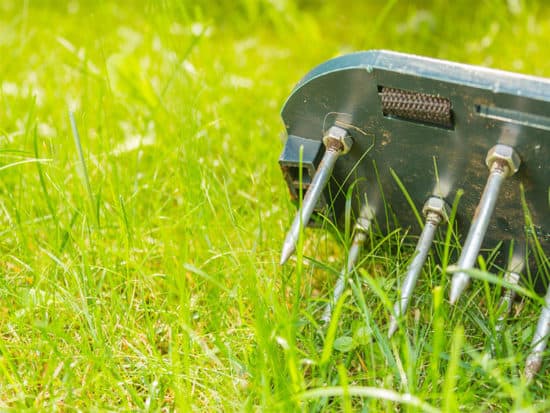
Wish to know which are all the benefits of aerating the lawn regularly? Here are the main advantages of this simple procedure over the soil:
Aeration Relieves Compaction
One of the top reasons plants and grass cannot grow healthy in compact soil. A compact lawn has little pore spaces between its particles, tiny spots that cannot allow water and nutrients to penetrate and move through the soil.
Imagine how stressful a plant cannot receive oxygen or water. Poor, almost none infiltration of moisture means weaker, thin grassroots and poor lawn. Once removing the small-sized plugs in the soil, compaction can be totally removed.
Improving Roots Growth
Deep roots need nutrients to grow healthy and strong. Furthermore, deep roots maintain the lawn’s health and stop possible landslides. However, these roots tend to be stunted once the soil is too compact.
Nevertheless, once you are aerating the lawn, you will see tiny new white roots coming through the holes you have created. This new roots growth process will make the soil less resistant, allowing other plants to develop beautifully.
Interesting fact! Most grassroots will continue their growth weeks after the lawn you have aerated no longer will need mowing during the late fall.
Seedbed Preparation
After aerating the lawn and seeding a thin lawn, the plants’ seeds will improve their germination, compared with overseeding. Furthermore, in addition to the seeds falling into the holes you have created during the aeration, the soil plugs are great helpers.
All those soil plugs that usually remain on the surface will break down in time and provide much seed-soil contact.
These simple methods will improve the amount of grass that will come up during springtime. In most of the temperate-continental areas, seeding works best during fall.
Thatch Management
Thatch is an accumulation of stems, decomposed roots, or any other plant material left for a long time. Once it builds too much, this thatch can cause lots of issues. Maybe you have already heard about the process of “dethatching” the lawn.
When you are mechanically ripping the thatch during the aeration process, you can penetrate through it, allowing oxygen to build and stimulate microbial growth. Warm temperatures will also increase the microbial development, and in turn, will lead to decomposed thatch.
In a nutshell, as soon as you will core the lawn in the fall or mid to late spring, the thatch will reduce. Higher temperatures will help in this process.
Aerating Lawn makes all other gardening activities easier.
Well, it might sound like a cliche, but once the lawn is perfectly aerated, many other gardening activities will be easier to fulfill. For instance, watering, feeding, applying nutrients, or weed control, all these processes will be more effective.
Down below, I will continue talking about another important aspect in aeration control: time. Make sure you respect the seasons when aerating the soil and consider the possible poor fertility, time of the year, soil acidity, and so on.
So, what is the better time to aerate the lawn?
What Is The Best Time To Aerate?
Okay, I have talked about the principle of aerating the lawn, its importance, and the advantages of this process. But when should you aerate the soil?
Well, when it comes to season grasses, such as Kikuyu, zoysia, or soft-leaf buffalo, you should aerate the lawn during spring and summer. In these periods, the grass is still growing.
However, you can start aerating the soil any time of the year, but keep in mind that the grass cannot cover all the aerated holes during the cooler months because it is dormant.
So, the best advice here is to try aerating the lawn at the same time you are fertilizing the soil, or you are doing other gardening operations such as top dressing or detaching.
An excellent time for aeration is after rainfall, as the lawn is moist and tender and makes the whole process lighter. Although aerating can sometimes be disregarded well, this simple process allows air, water, and the top nutrients to “feed” the plants.
How Often Should You Aerate The Soil?
Depending on the soil types, aeration can be different too, and the frequency you should do it changes.
For instance, clay soil types will need more aeration. Clay soils are usually easier to get too compact, so it should be aerated at least once per year. On the other hand, sandy lawns need less aeration, so once per year or once every two years should be enough.
If you have wide lawn areas with a large amount of foot traffic, children’s plays, pets, and cars, then compact soil will be the forever problem. Try to aerate the lawn regularly. This way, you can be sure that the ground does not become too compact or too hard for the plants to bread and the grass to spread uniformly.
Last Thoughts
It is never too late to improve your lawn’s health and upgrade the aeration techniques. I hope the information today will help you be a battery gardener.
How do you keep your lawns healthy?
